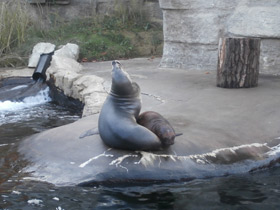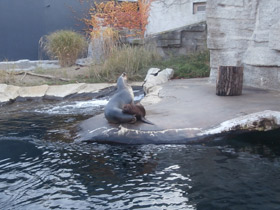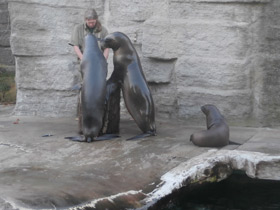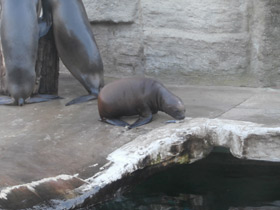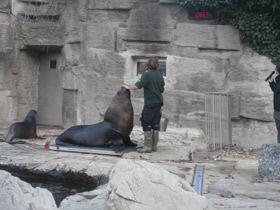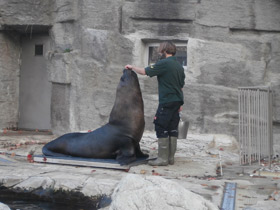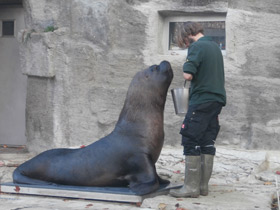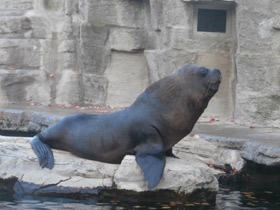The South American sea lion, the southern sea lion and the Patagonian sea lion (Otaria flavescens, formerly Otaria byronia)
The South American sea lion (Otaria flavescens, formerly Otaria byronia), also called the southern sea lion and the Patagonian sea lion, is a sea lion found on the western and southeastern coasts of South America. It is the only member of the genus Otaria. The species is highly sexually dimorphic. Males have a large head and prominent mane. They mainly feed on fish and cephalopods and haul out on sand, gravel, rocky, or pebble beaches. In most populations, breeding males are both territorial and harem holding; they establish territories first and then try to herd females into them. The overall population of the species is considered stable, estimated at 265,000 animals.
Naming
The South American sea lion was classified as Otaria flavescens by George Shaw in 1800 and as Otaria byronia by Henri Marie Ducrotay de Blainville in 1820. The two nomenclatures were historically used interchangeably, but Otaria flavescens has become the preferred name. The species is also known by the common name "southern sea lion", although it is not preferred since the Australian sea lion and New Zealand sea lion also range in the Southern Hemisphere. Locally, it is known by several names, including león marino (sea lion) and lobo marino (sea wolf).
Appearance
Otaria flavescens, formerly Otaria byronia, is a species of pinniped mammal in the family Otariidae.
Otaria flavescens are large seals: males can reach a size of up to 2.5 m and weigh up to 317 kg. They are dark brown on the upper body (although individuals may be grey, light golden or yellowish); they are yellowish brown on the underside. Adult males have long hairs on the neck and front of the chest, forming a mane; hairs on other parts of the body are sparse and stiff, without hair.
Females are much smaller, reaching only 2 m in length and weighing up to 140 kg. Their colouring is light brown and their coat usually has large, irregularly shaped patches scattered over the body.
Newborns are black, but soon turn brown or dark brown. In the fourth year of life, the colouring of males darkens to brown, while females become lighter and turn grey. Otaria flavescens has a considerable layer of fat that serves as thermal insulation.
Habitat
Otaria flavescens is distributed along the Pacific coast of South America, from Peru to Tierra del Fuego, and along the Atlantic coast to southern Brazil. There are also colonies of southern sea lions in the Falkland Islands.
Occasional vagrants can also be found far from the main colonies, for example in the Galapagos Islands or in the northernmost parts of the Brazilian coast.
Outside the breeding season, Otaria flavescens maintain large mixed flocks, at which time they still do not stray far from breeding areas, although they may spend much time at sea. They sometimes enter large rivers, for example, they were once found in the Rio de la Plata 300 km from the mouth of the river. No true migrations of these pinnipeds have been recorded, although southward movements have been described in some populations.
Nutrition
The diet of Otaria flavescens consists mainly of squid, crustaceans, small fish and sometimes penguins. They sometimes feed in groups, especially when hunting shoals of fish or squid.
Breeding
The breeding season of Otaria flavescens begins when adult males appear near islands and on mainland shores on beaches or in flat spaces between rocks. They come ashore and occupy certain areas, sites of future harems. Mature males compete with each other for the coastal plots. In these fights, rivals try to bite each other, often resulting in bloodshed and deep wounds. The weaker males are pushed to the edge of the colony, while the stronger ones earn the right to the most prestigious spots in the centre of the colony. Even at high tide, when the water almost covers them, the males do not leave their territories.
Females approach the colonies in November and by December most harems are formed. When they reach the shore, the females join the harem of the male who owns the area. A harem may consist of 18 females, but the closer a male's plot is to the edge of the colony, the smaller his harem will be. On average, each male has three females when he mates. Males are constantly busy preventing females from leaving their territory, and often infiltrate neighbouring areas and clash with their hosts.
Young males sometimes gather in bachelor groups of up to ten animals, regularly attempting to enter the colony, steal a female and mate with her. While on land for two to three months, the male hardly eats or sleeps, and the females give birth to young and, after a few weeks of nursing, are ready to mate again. As the number of females increases, males stop controlling territories and start guarding groups of females. Unlucky males without their harems gather at the ends of beaches and attack females to mate with them.
Pregnancy in Otaria flavescens lasts about 350 days. Hatching occurs from late December to mid-January (most females in early January). Females give birth to one young, rarely two, of about 80 cm body length. The hair of the newborn calf is black.
For the first few days, the calves stay close to the females, who do not enter the water. But after a new pregnancy, the females regularly go out to sea to feed, and the newborn calves often leave their parents' hiding places and congregate in isolated areas nearby.
It has been observed that each female feeds only her calf, which she apparently recognises by its smell and voice.
Until they are one month old, the calves do not know how to swim, although they make attempts to float in coastal puddles. They then go to the sea, where the females teach them to swim.
Milk feeding in Otaria flavescens is prolonged, probably for at least 5 months.
In early February, the harems separate and the animals switch to a marine lifestyle.
In April the colonies fill up again, as the animals leave to moult.
Females reach sexual maturity at the end of the fourth year of life and males at the age of 6 years. The life expectancy of sea lions is probably about 20 years. They have few natural enemies: young animals are sometimes attacked by leopard seals.
Human interactions
The Moche people of ancient Peru worshipped the sea and its animals. They often depicted South American sea lions in their art. Two statues of this species are the symbol of the city of Mar del Plata.
Indigenous peoples of South America exploited this species for millennia and by Europeans around the 16th century. The hunting has since gone down and the species is no longer threatened. The species is protected in most of its range. Numerous reserves and protected areas at rookeries and haul-out sites exist for the sea lions. Despite this, protection regulations are not effectively enforced in much of animals' range.
The overall population of sea lions is considered stable; the estimate is 265,000 animals. They are declining in the Falkland Islands, and in Argentina Patagonia, but are increasing in Chile and Uruguay. Many sea lions of the Peruvian population died in the 1997/1998 el Niño. They still are killed due to their habits of stealing fish and damaging fishing nets.

















